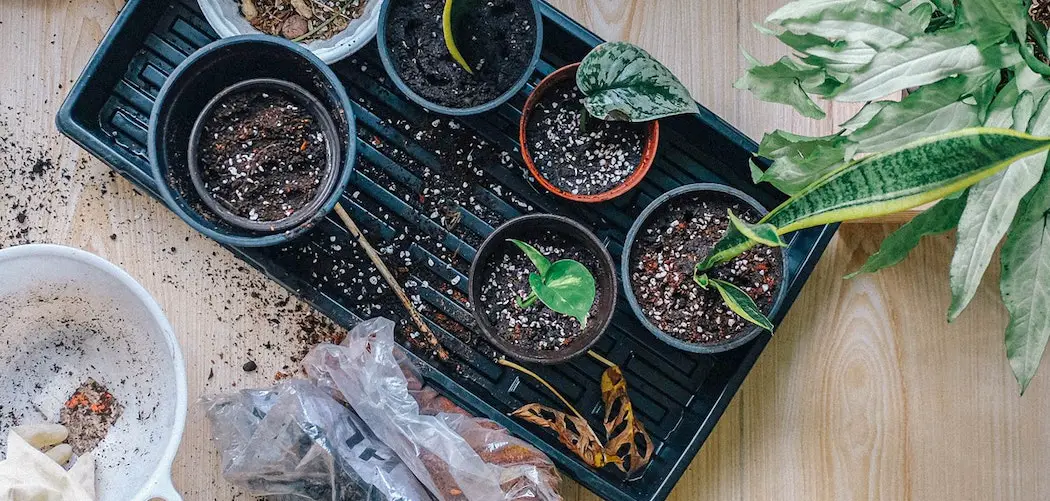Vermiculite is a mineral with some truly unique properties. It retains water and nutrients, slowly releasing them over time, and also has the added benefit of aerating the soil of your plants.
However, not all houseplants benefit from it.
In this article, we will go over the top 10 houseplants that love vermiculite and exactly how you can use it:
1. Spider Plant (Chlorophytum Comosum)

Spider plants are beautiful, easygoing plants that grow long, spindly leaves in every direction. Some varieties are striped, while others are plain green. They love to dangle from shelves and high ledges, and are much-loved houseplants.
Spider plants really enjoy the slow-release properties of vermiculite. This can also help you to reduce how often you have to water your plants, and reduces the risk of them dying if you forget for a while.
To use vermiculite for spider plants, mix a quarter or less in their soil. If you are potting up some baby spider plants, they will enjoy having a bit of vermiculite mixed through their compost.
These plants are not fussy and will grow in almost any conditions, but having some water-retaining vermiculite in the soil will certainly help.
Vermiculite is therefore a great addition to the pots of spider plants, although they don’t need a large amount in order to reap the benefits.
2. Pothos (Epipremnum Aureum)

Sometimes known as devil’s ivy, pothos plants are elegant trailing plants, with rich green leaves. Their foliage is usually lightly variegated and grows in long trails down walls, and their arrowhead leaves are very attractive.
Pothos plants will really benefit from being planted with some vermiculite. This will help to keep the soil light and airy, which the pothos prefers, and will ensure that it traps moisture for the plant to tap into.
Both of these things are ideal for keeping your plant happy, and will minimize the risk of you forgetting to water your plant.
For the best results, make sure you mix vermiculite right through the soil of your Pothos, rather than just putting it in the bottom of the pot. Less than 1 part vermiculite and 3 soil should be enough.
This will ensure that the soil around the plants’ roots stays loose, and maximizes the oxygen that this plant can absorb.
3. Lucky Bamboo (Dracaena Sanderiana)

Lucky bamboo is an impressive plant that is easy to train, and it grows attractive, thick green stems with crowns of leaves coming from the top.
If you want to grow some very happy lucky bamboo, try adding some vermiculite to this container.
Lucky bamboo loves water – and can be grown directly in water, rather than soil – so it will be happiest if its pot has plenty of vermiculite incorporated into it.
Interestingly, this plant isn’t actually related to bamboo, in spite of its name and appearance. It likes plenty of air and water around its roots, and vermiculite will provide both in abundance.
To make use of vermiculite with your lucky bamboo, you can mix it with all kinds of other soil amendments. Lucky bamboo can handle a full vermiculite potting medium, but it will give the best results when mixed.
Lucky bamboo also enjoys pumice, sand, perlite, coconut coir, and peat moss in its soil, so add these alongside the vermiculite, and keep your plant happy.
4. Philodendron

Philodendrons have big, satisfying leaves that may be plain or striped. They are again climbing plants, and they have become extremely popular because of the rich, tropical atmosphere they lend to homes.
Like the pothos plant, philodendrons love vermiculite because they like to have air and water in abundance.
The looser and damper the soil is, the happier this plant will be. Some people grow their philodendron plants in pure peat moss to provide the right environment, but vermiculite is also a great option.
However, you do want to make sure that the pot has good drainage so that the plant isn’t sitting in water.
To efficiently use vermiculite with your Philodendron, mix it throughout the soil and check regularly that the drainage holes haven’t got clogged up, or your plant’s roots may rot.
5. Maidenhair Fern (Adiantum)

Maidenhair ferns are famous for their delightful foliage, which looks like miniature treetops and is highly attractive. These ferns are feathery and gorgeous, and many people love their delicate fronds.
Many ferns prefer damp conditions, and the maidenhair fern is no exception, so it will love being given plenty of vermiculite.
To make the best use of vermiculite’s properties on your Maidenhair fern, pot the plant with an equal mix of perlite, vermiculite, and peat moss, as this will help to trap moisture and keep it available at all times.
Mix a third of each of these mediums together and pot up your plant; this should keep it happy.
Make sure you are watering it fairly frequently, but don’t give it too much to drink, as this mixture will retain moisture well and hold it in the soil.
6. Swiss Cheese Plant (Monstera)

You may already be familiar with Monsteras, which have huge leaves and are superb climbers.
They are known for their amazing leaf fenestrations and they really benefit from having vermiculite in their pots.
They grow in soil that is loose and airy, as well as constantly fairly damp.
Monsteras benefit from vermiculite because it helps to mimic rainforest conditions, and is often mixed into the containers, along with perlite and sphagnum moss in equal quantities.
7. Calathea

Calatheas are known for their extraordinary beauty. They look like their leaves have been hand-painted with amazing stripes of varying colors. Many leaves have purple undersides.
Like other rainforest plants, these thrive in loose potting mix, but they also like plenty of moisture.
To use vermiculite for Calathea, combining it with things like orchid bark and coconut coir (which will not hold onto water) will help to ensure that the plant doesn’t get dried out. Mixing it in equal quantities is best.
Without vermiculite, there’s a risk of this dry, tough potting mix not absorbing enough water for the plant to drink.
The vermiculite has the added advantage of keeping the soil loose if you aren’t using orchid bark, so make sure you include it regardless of your other potting medium.
8. Peace Lily (Spathiphyllum)

The peace lily has dark, glossy green leaves, and amazing white flowers that give it its name. There is something very tranquil about these plants, but like other jungle plants, they prefer a damp environment.
If you find your peace lily is always drooping and looking sad, try mixing some vermiculite into its soil. This will trap the moisture and ensure that your plant has enough to drink.
However, be careful not to over-water a peace lily if you have used vermiculite, as this becomes a bigger risk.
When using vermiculite for your Peace lily, don’t forget to add some coconut coir or orchid bark alongside it to improve drainage.
That might sound contradictory, but the vermiculite will soak the water in and hold onto it until the plant is ready for it, rather than letting it sit by the plant’s roots at all times.
The coconut coir will encourage the rest of the water to flow out of the pot.
9. Basil (Ocimum Basilicum)

Lots of people are eager to grow basil at home, and on the whole, this herb is reasonably easy to be successful with – but you do need to provide the right conditions for it.
Basil likes plenty of water, but there’s a risk of its roots rotting if you water it too often.
This is a particularly big risk with basil seedlings, so vermiculite is a great thing to mix into the pot when you first plant the basil. Add about a third of vermiculite with one third organic matter (e.g. leaf mold, peat moss), and one third potting soil.
This should provide the basil with the drainage it needs, but ensure that it still has plenty of water available.
Like most herbs, basil doesn’t like to be kept wet, but does like to have access to water most of the time.
10. Jade Plant (Crassula Ovata)

Jade plants are gorgeous succulents with plump, satisfying, glossy foliage. They have thick stems and they can grow quite large. Like other succulents, it’s fairly easy to take cuttings from this plant, but you need to grow them in the right potting medium.
Jade plants love vermiculite. Doing a 50:50 mix with half of the pot being full of soil, and the other half being full of vermiculite will work best for Jade plants.
This will give the jade plant plenty of nutrients, but will also ensure that there is always moisture available to it.
Because it’s a succulent, it’s easy to over-water a jade plant. The vermiculite will suck in the moisture and release it back to the plant slowly, ensuring your jade plant gets what it needs when it needs it.
Final Thoughts
Many plants will benefit from the extraordinary properties of vermiculite, and it’s worth using it when you are potting up a new houseplant.
The slow-release of water makes this material extremely useful and gives your houseplants protection against drying out – so it’s ideal if you aren’t good at remembering to water regularly!


